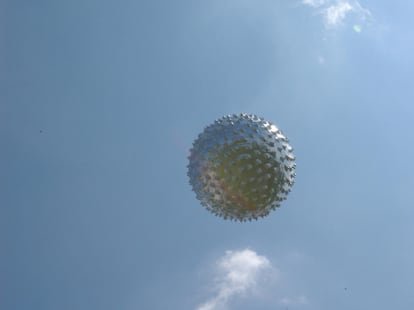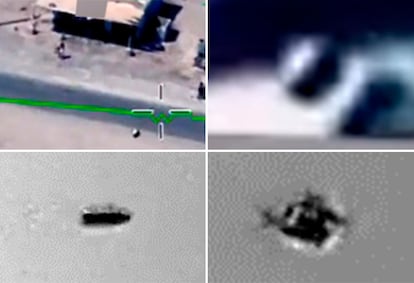Stigma, sensationalism and a cell phone app: The main takeaways from NASA’s UFO report
The agency will apply the scientific method and use all the tools at its disposal to figure out the origins of unidentified anomalous phenomena


The long-awaited NASA report on unidentified flying objects (UFOs) — or, more precisely, unidentified anomalous phenomena (UAP) — commissioned to a group of independent experts, has led to the agency’s appointment of a research director for the subject. But that was done in a peculiar way: at the press conference to present these new developments at the agency’s Washington headquarters, the person who would occupy this position was not named. In a surprise announcement eight hours later, NASA posted that Mark McInerney — who previously served as the agency’s liaison with the U.S. Department of Defense and therefore has experience dealing with sensitive issues — will head the research effort.
The panel’s study contains the keys to NASA’s potential future involvement in the search for explanations to any mysteries that may arise, and it also offers recommendations for better understanding such phenomena through scientific method. Doing so, the report contends, may help to overcome the stigma sometimes attached to sighting reports from aeronautical professionals who may find their careers in jeopardy as a result. The experts did not find any evidence that the phenomena had extraterrestrial origins, but they do not entirely discard that possibility, either. However, they warn that it is time to move from sensationalism to science.
1. New name
For decades, people have been fascinated with UFOs, an interest fed by Hollywood science-fiction blockbusters. Partly to overcome the association of UFOs with flying saucers and extraterrestrials and partly to cover broader phenomena that are not strictly flying objects, scientists and official agencies (including the Pentagon) began to speak of unidentified aerial phenomena (UAP) instead. Later, aerial or atmospheric was changed to anomalous, in order to include potential phenomena in other environments, like the sea. The NASA report uses the term UAP, but that acronym has not yet taken hold in the broader population.
2. Stigma
The NASA report was adamant about the need to overcome the stigma around UAP sightings, which stems in part from the association between UFOs and extraterrestrials. For example, aircraft pilots sometimes prefer not to report UAP they have seen for fear of being considered unstable or unhinged. NASA believes that its involvement in the study of such phenomena can be helpful in this regard.

“The negative perception surrounding the reporting of UAP poses an obstacle to collecting data on these phenomena. NASA’s very involvement in UAP will play a vital role in reducing stigma associated with UAP reporting [...] NASA’s long-standing public trust, which is essential for communicating findings about these phenomena to citizens, is crucial for destigmatizing UAP reporting. The scientific processes used by NASA encourage critical thinking; NASA can model for the public how to best approach the study of UAP, by utilizing transparent reporting, rigorous analysis, and public engagement,” the report says.
3. The mystery
NASA’s report is not a review of past incidents, but rather a series of methodological recommendations. The team of 16 experts has analyzed only unclassified information, which somewhat limits the study’s scope; however, NASA maintains that this was the only way to unreservedly state their opinions. There are not many conclusions about the nature of the phenomena. The report is illustrated with images of meteorological and atmospheric phenomena, in what appears to be a subliminal message.
A section is devoted to debunking one of the most famous sightings, the so-called GoFast sighting, a Pentagon video in which an object appears to move at high speed (above video). The scientists believe that this is an optical illusion resulting from the observer’s movements and relative positions, and they use geometry to point out that the speed would only be 40 miles per hour.
The report also concedes that UAP “are one of our planet’s greatest mysteries,” but it does not go into more detail. “Despite numerous accounts and visuals, the absence of consistent, detailed, and curated observations means we do not presently have the body of data needed to make definitive, scientific conclusions about UAP,” the report states.
4. Extraterrestrials
The word “extraterrestrial” appears a dozen times in the report. In presenting the study, NASA Administrator Bill Nelson was convinced that there is life beyond Earth, but experts have not found any indication that the UAP are extraterrestrial in origin. “To date, in the peer-reviewed scientific literature, there is no conclusive evidence suggesting an extraterrestrial origin for UAP,” the report says.

The extraterrestrial aspect clearly arouses passions. Some members of the expert panel have been harassed for participating in the report. “Study Team members also noted firsthand knowledge of colleagues who were warned to stay away from research in areas like extraterrestrial technosignatures, which could damage their scientific credibility and promotion potential. These experiences further confirm the negative stigma associated with studying unusual or unexplained phenomena. Such criticism, either by detractors or by proponents of the extraterrestrial hypothesis, are anathema to the scientific method, which NASA always has and will continue to promote in an objective and open-minded fashion,” one of the document’s appendices explains.
In other words, NASA sees no reason to consider extraterrestrial origins, but it does not completely discard the possibility, either. “In the search for life beyond Earth, extraterrestrial life itself must be the hypothesis of last resort — the answer we turn to only after ruling out all other possibilities. As Sherlock Holmes said, ‘Once you eliminate the impossible, whatever remains, no matter how improbable, must be the truth.’”
5. From sensationalism to science
NASA administrator Bill Nelson said that one goal of the agency’s involvement is to shift the conversation about UAP “from sensationalism to science.” The entire report employs the scientific method to examine the issue. In that vein, during Thursday’s press conference, the director of the team of experts was asked about the alleged non-human mummies from Nazca recently exhibited in the Mexican Congress.

“This is something I have only seen on Twitter [now called X]. When you have unusual things, you want to make data public,” David Spergel has said; NASA itself did so with moon rocks. “If you have something strange, make samples available to the world scientific community and we’ll see what’s there,” he added. Another speaker said that it is simply a matter of moving “from conjecture and conspiracy towards science and sanity.”
6. Bringing NASA’s technological muscle to bear
At the heart of the report are its recommendations for how NASA can improve its study of the phenomena. The agency submitted eight questions to the experts about the type of data now being collected, what data should be obtained, what technologies should be used to process them, and so on. The experts point out that the observations now available are often unintentional; they appear when one is looking for or at other things. They suggest taking advantage of existing technologies, expressly dedicating some resources to studying UAPs, using artificial intelligence and automatic learning tools, documenting the findings in standardized databases, and coordinating with other agencies. The report even broaches the idea of creating a collaborative cell phone application that allows citizens to contribute their own observations in a standardized way.
“We recommend that NASA play a prominent role in the whole-of-government effort to understand UAP by leveraging its extensive expertise to contribute to a comprehensive, evidence-based approach that is rooted in the scientific method. We specifically recommend that NASA utilize its existing and planned Earth-observing assets to probe the local environmental conditions associated with UAP that are initially detected by other means,” say the experts. They further advise increasing cooperation with the private U.S. remote-sensing industry, which has powerful constellations of high-resolution Earth observation satellites.
“At present, the detection of UAP is often serendipitous, captured by sensors that were not designed or calibrated for this purpose, and which lack comprehensive metadata. Coupled with incomplete data archiving and curation, this means that the origin of numerous UAP remain uncertain. The importance of detecting UAP with multiple, well-calibrated sensors is thus paramount,” the report states.
You can follow us on Facebook, Twitter and Instagram, or sign up here to receive our weekly newsletter.
Tu suscripción se está usando en otro dispositivo
¿Quieres añadir otro usuario a tu suscripción?
Si continúas leyendo en este dispositivo, no se podrá leer en el otro.
FlechaTu suscripción se está usando en otro dispositivo y solo puedes acceder a EL PAÍS desde un dispositivo a la vez.
Si quieres compartir tu cuenta, cambia tu suscripción a la modalidad Premium, así podrás añadir otro usuario. Cada uno accederá con su propia cuenta de email, lo que os permitirá personalizar vuestra experiencia en EL PAÍS.
¿Tienes una suscripción de empresa? Accede aquí para contratar más cuentas.
En el caso de no saber quién está usando tu cuenta, te recomendamos cambiar tu contraseña aquí.
Si decides continuar compartiendo tu cuenta, este mensaje se mostrará en tu dispositivo y en el de la otra persona que está usando tu cuenta de forma indefinida, afectando a tu experiencia de lectura. Puedes consultar aquí los términos y condiciones de la suscripción digital.
More information
Archived In
Últimas noticias
Most viewed
- Reinhard Genzel, Nobel laureate in physics: ‘One-minute videos will never give you the truth’
- Oona Chaplin: ‘I told James Cameron that I was living in a treehouse and starting a permaculture project with a friend’
- Pablo Escobar’s hippos: A serious environmental problem, 40 years on
- Why we lost the habit of sleeping in two segments and how that changed our sense of time
- Chevy Chase, the beloved comedian who was a monster off camera: ‘Not everyone hated him, just the people who’ve worked with him’










































